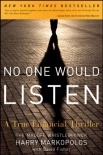No One Would Listen: A True Financial Thriller, Harry Markopolos [graded readers .TXT] 📗

- Author: Harry Markopolos
Book online «No One Would Listen: A True Financial Thriller, Harry Markopolos [graded readers .TXT] 📗». Author Harry Markopolos
As Frank has occasionally pointed out, Mother Teresa did not work on Wall Street. The object of the business is to use money to make money; there is no interest in saving souls. Whatever Madoff was doing and precisely how he was actually doing it didn’t concern Frank as much as his results. When Frank got back to the office, he handed Dave Fraley copies of Access’s revenue stream for at least the last year that Thierry had given him. “Look at this. Access has a guy who’s producing one percent, one and a quarter percent a month with a split-strike conversion strategy.”
Fraley looked it over. He didn’t speak numbers like a quant, but he didn’t need that kind of expertise to understand the kind of returns that Madoff was producing. The bottom line was right there. As Fraley stared at it, Frank suggested, “You know, if we can come up with something that’ll produce anywhere near those returns, Access can raise a lot of money.”
A few minutes later, Frank handed me the copies of the revenue stream. This comes from that manager in New York we were wondering about, he said. He’s running a split-strike conversion. And then he added, “Harry, if we do something similar we can make a lot of money.”
I glanced at the numbers. I’d spent countless thousands of hours preparing for this moment. And I knew immediately that the numbers made no sense. I just knew it. Numbers exist in relationships, and after you’ve studied as many of them as I had it was clear something was out of whack. I began shaking my head. I knew what a split-strike strategy was capable of producing, but this particular one was so poorly designed and contained so many glaring errors that I didn’t see how it could be functional, much less profitable. At the bottom of the page, a chart of Madoff’s return stream rose steadily at a 45-degree angle, which simply doesn’t exist in finance. Within five minutes I told Frank, “There’s no way this is real. This is bogus.”
As I continued examining the numbers, the problems with them began popping out as clearly as a red wagon in a field of snow. There was a stunning lack of financial sophistication. Anyone who understood the math of the market would have seen these problems immediately. A few minutes later I laid the papers down on my desk. “This is a fraud, Frank,” I told him. “You’re an options guy. You know there’s no way in hell this guy’s getting these returns from this strategy. He’s either got to be front-running or it’s a Ponzi scheme. But whatever it is, it’s total bullshit.”
And that’s when we began chasing Bernie Madoff.
Chapter 2
The Slot Machine That Kept Coming Up Cherries
Month after month, year after year, no matter how wildly the market performed, Madoff’s returns remained steady. He reported only three down months in more than seven years. His returns were as reliable as the swallows returning to Capistrano. For example, in 1993 when the S&P 500 returned 1.33 percent, Bernie returned 14.55 percent; in 1999 the S&P 500 returned 21.04 percent, and there was Bernie at 16.69 percent. His returns were always good, but rarely spectacular. For limited periods of time, other funds returned as much, or even more, than Madoff’s. So it wasn’t his returns that bothered me so much—his returns each month were possible—it was that he always returned a profit. There was no existing mathematical model that could explain that consistency. The whole thing made no sense to me. Bernie Madoff was among the most powerful and respected men on Wall Street. He had founded and operated an extremely successful broker-dealer firm. How could he be perpetrating such a blatant fraud? And if it was so obvious, why hadn’t other people picked it up? I kept looking at these numbers. I had to be missing something.
I didn’t obsess over this, but I was really curious. It was like trying to solve a jigsaw puzzle using pieces that didn’t fit. In certain markets a split-strike conversion strategy actually could produce the returns Madoff was delivering, but it can’t make money in all types of markets as de la Villehuchet had claimed. You can’t take whatever you want from the market; you have to take what it gives you—and sometimes that means a down month. Every product in the entire history of the financial industry has a weakness—except for Bernie Madoff’s. He was the slot machine that kept coming up cherries. And I wanted to figure out how he was doing it.
During the next few weeks I began modeling his strategy. He claimed that his basket of about 35 securities correlated to the S&P 100. Right from the beginning that made no sense to me, because it meant he had single stock risk. He couldn’t afford for even one of his 35 stocks to go down substantially, because it would kill his returns. So he needed all 35 stocks to go up or at least stay the same. While I knew that in reality it was impossible to successfully pick 35 stocks that would not go down, I accepted the dubious assumption that information from his brokerage dealings allowed him to select the strongest 35 stocks. But because this basket represented about a third of the entire index, there still should have been a strong correlation between his returns and those of the underlying index. When the whole index went up, his stocks would rise; when the index fell, so would his stocks. But that’s not what he was reporting. Whatever the index did, up or down, he returned the same 1 percent per month. In almost





Comments (0)